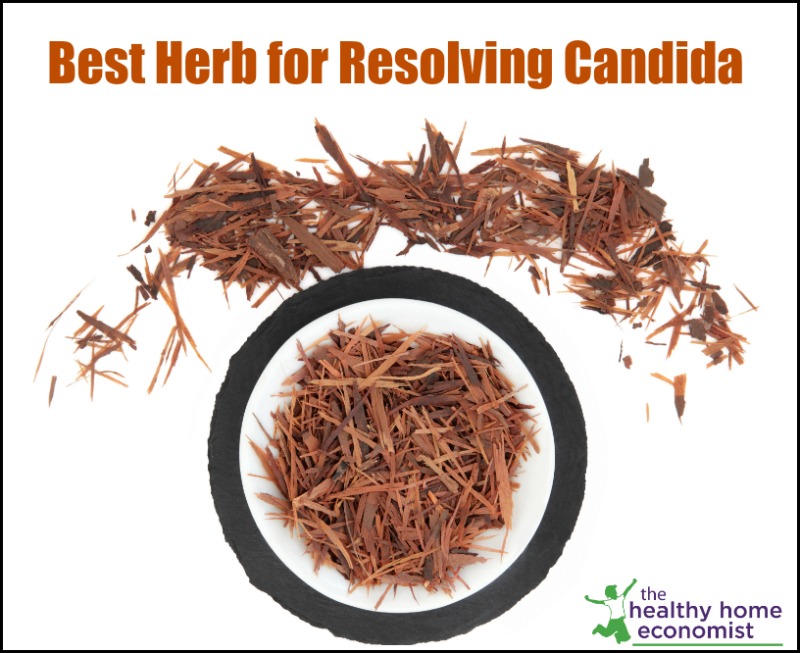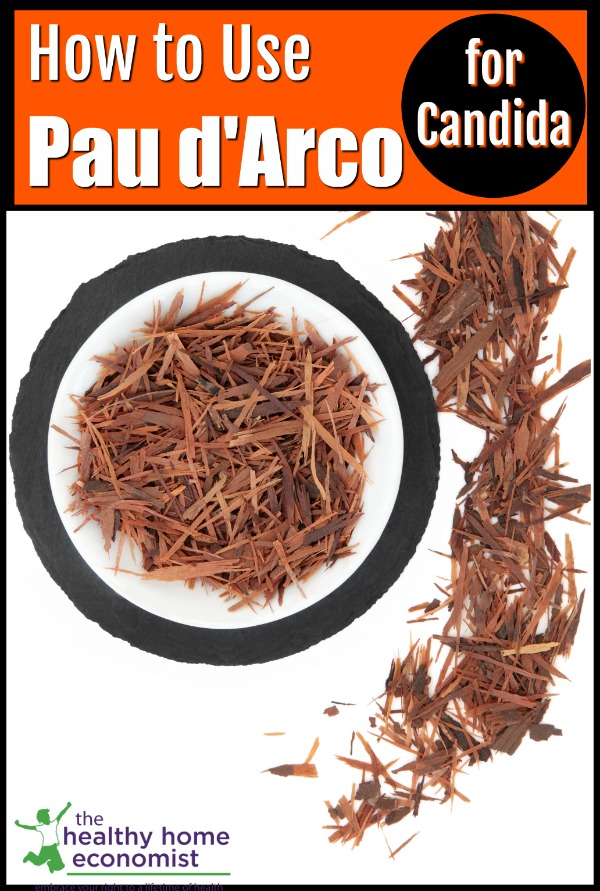Table of Contents[Hide][Show]
Why Pau d’Arco is the best anti-candida herb and how to use it to get back on track with healthy diet after consuming too many sweets on vacation or holidays.

At no time during the year is the herb Pau d’arco needed more than during vacation or the holidays!
Having an awesome time while on break is wonderful and fine. However, the risk of off-the-wagon eating during this time is quite sneaky. Bad habits can make their way into our regular routine almost without us realizing what happened.
Have you ever experienced this yourself?
A week or two after the vacation has ended, you may still find yourself eating like you did on break! This can domino into candida overgrowth symptoms like waking up with brain fog, eating midafternoon candy bars or donuts for breakfast, and suffering from stiff or painful joints.
Has this has ever happened to you? Then, you know that the first day or two back on the wagon eating 100% healthy is definitely the hardest.
Those little critters known as gut pathogens which are normally in the minority in a healthy, balanced gut had a heyday while you were eating with abandon. They likely multiplied quickly and have increased greatly in proportion to the beneficial flora.
Pau d’Arco Inhibits Candida
The typical pathogen that overgrows during a period of off the wagon eating is Candida. This term refers to a large family of yeasts comprising 150+ species. Six of these are normally responsible for the bulk of human fungal infections.
Under normal circumstances, these one-celled fungi harmlessly inhabit the tissues of humans.
A balanced intestinal tract from mouth to colon easily keeps pathogenic yeasts in check. In other words, the good guys keep candida overgrowth from taking hold.
When not enough beneficial bacteria are present in a given body tissue to keep Candida under control, pathogenic strains can transform from a harmless state into an invasive species.
Candida overgrowth can occur in many tissues of the body. For example, pathogenic yeasts can take hold in the mouth as oral candidiasis known as thrush.
It can also occur in the scalp as dandruff, in the feet as fungus toenails, or internally as stubborn vaginal yeast infections and UTIs.
Cutting off Candida’s goodies and protective biofilms by eliminating the dietary junk allows the beneficial microbes to re-exert their authority and bring gut pathogens back into subjection. Hopefully, this occurs before they start causing health issues.
Once given a foothold, pathogenic yeast won’t go away easily!
It takes about 24-72 hours of perfect eating to get over the hump in my experience. After that, you will likely find healthy eating comfortable again. You won’t be craving treats or junk all day long. This means blood sugar will stabilize back into a normal steady routine without excessive peaks or valleys.
The good news is that herbs can provide much-needed assistance during those initial difficult hours when the gut pathogens like Candida are clamoring for their sugar fix and you are struggling to put an end to the feeding frenzy.
The best herb to use for this purpose is Pau d’Arco, also known as Tabebuia.
The Pau d’Arco herb is derived from the inner bark of a beautiful, large tree that is native to the rainforests of Central and South America. It will grow in any warm, humid clime. I am fortunate to have two of these beautiful trees, Tabebuia impetiginosa, growing in my front yard.
Candida Diet Recommends Pau d’Arco
I first learned about Pau d’Arco while on the Candida Diet over 30 years ago.
Although the Candida Diet failed miserably to improve the health either of myself or my husband (we eventually realized that eating traditionally was the way to healing and health, not fad diet silver bullets), we found this powerful herb highly effective at repressing Candida and significantly reducing sugar cravings.
Pau d’Arco has been used as a medicine to counteract fungal overgrowth for centuries. Science is validating these anecdotal observations with solid research.
For example, the Brazilian Journal of Biology found that Tabebuia avellanedae, one tree species that is the source of the Pau d’Arco herb, does indeed exert an inhibitory effect on yeasts. (1)
What Form is Best?
Pau d’Arco is most often consumed as a medicinal herbal tea (this is the brand I use).
Warning…it is an acquired taste at best! Even after drinking it as needed for the past 2 decades, I still don’t like it much!
The good news is that the taste isn’t so terrible that you can’t drink a cup or two for a few days. This practice will help you get back into the routine of healthy eating with far less agony.
If you absolutely cannot stand the bitter taste, try using a Pau d’Arco tincture instead (this is a good brand to try).
How much sugar is too much? The definition of sugar moderation is less than 36 grams (3 tablespoons) per day. Most importantly, this includes fruit and fruit juice.
To give you an idea of how little sugar this actually is, one navel orange contains approximately 23 grams of sugar.
More than 36 grams of sugar per day causes significant immune system impairment. This limit is based on the research described in the classical compendium Search for Health by Tom Valentine.
How to Use
Two cautions with regard to consumption of Pau d’Arco tea are to start slow! This avoids uncomfortable Candida die-off symptoms.
Secondly, make sure you get the real thing.
There are Pau d’Arco imposters out there, so make sure the source of your herb is either the Tabebuia avellanedae tree or the Tabebuia impetiginosa tree.
Mahogany bark, for example, apparently has a similar color and aroma to the bark of the Pau d’Arco tree but does not have its beneficial effects when consumed as a tea.
Getting back on the healthy eating wagon is not nearly as tough when you use Pau d’Arco as a helpful herbal tool!

(1) Antimicrobial potential of some plant extracts against Candida species
More Information
Biofilms in treating Candida
The 11 Best Natural Antibiotics and How to Use Them
Can Candida Sufferers Drink Kombucha?
Slippery Elm for Natural Digestive Relief
Rooibus Tea: Delicious and Naturally Caffeine Free
Top 3 Herbs for Fertility








Dearest Sarah… First, thank you so much for your article on the Pau d’Arco Tea.
I have come to the conclusion that I suffer badly from Candida… at 65-years-old, it is a condition that set upon me two-years ago. I suffer from constantly recurring Yeast infections and now Boils!
I treated the Yeast infections with over-the-counter 7-day Monistat cream, and it would go away for a while but always come back. However, when I got the first Boil, it was so excruciatingly painful, I went to the doctor.
Do you know what he told me when I asked him, ‘What is this thing? Why do I have this?’ He said, ‘Hygiene’. I was shocked. I looked him straight in the eye and said, ‘Hygiene? Doctor, I’ve been bathing this body for 63-years and now, all of a sudden, my ‘hygiene’ isn’t right? Do try again’.
He looked sheepish and said, ‘We really don’t know what causes a Boil. Mostly, we consider it an effect of an ingrown hair.’ To which I replied, ‘Hmmm.’
He gave me a prescription for antibiotics, (which, in the end, only caused a worse Yeast infection), but did rid me of the Boil.
However, not a month later, I got not only another Boil, but 3 of them in a cluster!
Unwilling to go back to the doctor in a never-ending revolving door of antibiotics, no reasonable answer to my malady, and NO CURE in sight, I’ve been treating this condition with Echinacea, (in a Tea, homeopathic Vibropathic, and poultice ), and a liquid Probiotic. These have kept the Boils at bay, but, I still get them from time-to-time… only twice in the last year as opposed to every month when it first started happening. Still, not a cure.
It finally dawned on me the other day that the Yeast infections and the Boils may very well be linked. Hence, my search led me to Candida, and that led me now to you.
MY QUESTION: You mention in your article to… ‘make sure the source of your herb is either the Tabebuia avellanedae tree or the Tabebuia impetiginosa tree’; and respond to an Asker that you recommend this product over on Amazon ‘Traditional Medicinals Teas Pau d’Arco Herbal Tea’, wherein on the box it states, ‘TABEBUIA SERRATIFOLIA’.
Since the box states neither ‘Tabebuia avellanedae’ or ‘Tabebuia impetiginosa’, this has confused me. Can you help in clarifying whether the product you’re recommending is, indeed, made from either of the two trees you state ‘Pau d’Arco’ should be made from? Thank you.
I have used Pau Darco capsules for a month to fight Candidas along Yeast cleanse and found great results. I now only use Pau Darco capsules for maintenance. Is it fine? Which one is better? Tea or capsules? And how long should I use? Thanks.
How much pau d’arco herb to consume if you have a growth inside of stomach – have had 2 gastro surgery don’t want a third.
Pau d’Arco is not going to help in this type of situation.
Hi, I would like to know your diet at this time, what do you eat and what do you avoid? How did you control candida initially?
In other words, what was your diet like in the beginning and how long to a normal diet avoiding sugars?
Thank you.
Please recommend a brand for Pau d’arco tea.
We use this one: http://amzn.to/2vkiRhS
Is it safe while nursing?
It is recommended against using it during pregnancy and lactation. paudarco.org
Sarah,
How long before I start seeing some results while drinking pau darco tea 2 times a day?
I personally feel it right away — within one or two cups.
Fruit? That is ridiculous. Fructose is not the same as sucrose. Fructose does not promote fungal overgrowth.
Soooo many unknowingly people keep their candida going by eating far too much fruit and on an empty stomach too which really spikes the blood sugar. In fact, fructose is implicated very strongly in metabolic syndrome and obesity. Keep that fruit in moderation and always eat with a healthy fat (e.g., strawberries and cream) like traditional peoples did to keep the blood sugar in check.
Is Pau d’Arco safe to use while breastfeeding?
Hi Sara. I am loving your site. I also found your page on why the candida diet doesn’t work because if grains. I know in this article you said not to do the diet and instead follow the traditional way of eating. I just realized I am suffering from candida and have been for many years. I never knew that all my symptoms were from that – we ate organic – but still a lot of sugar and wheat and fruit. I am I so much pain, I really want to get rid of this but I am finding such conflicting information. I would really appreciate your input as I respect your knowledge. Thank you.